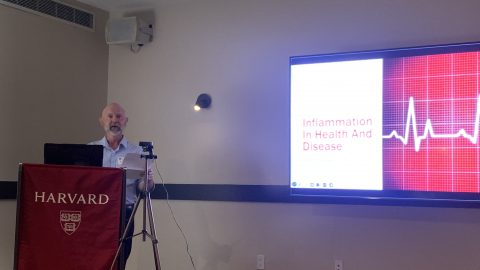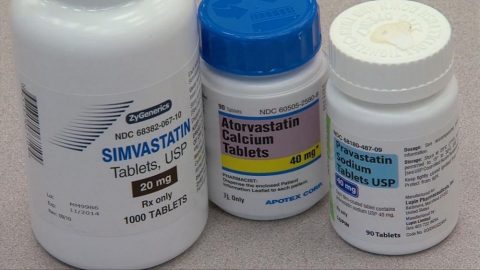In a previous post I outlined the U-shaped relationship between IGF-1 and all-cause mortality.
A growing body of research shows that IGF-1 has a U-shaped relationship with other health outcomes as well, including cancer. This may come as a surprise, as IGF-1 is well-known to increase cancer risk…
IGF-1 and cancer
It is well documented that IGF-1 plays a role in cancer development and progression.[1, 2] Population studies shown that high levels of serum (blood) IGF-1 (when compared with low levels, within the normal range) and/or lower levels of IGFBPs are associated with increased risk for several cancers, including premenopausal breast cancer [3-5], prostate cancer [6, 7], lung cancer [8], colorectal carcinoma [9-11], endometrial cancer [12], and bladder cancer [13].
A study in men aged 50 yr and older investigated the relation of baseline IGF-1 levels and total cancer mortality with a follow-up of 18-years.[14] After adjusting for IGFBP-1, age, BMI, waist-to-hip ratio, exercise, current smoking, and previous cancer, it was found that risk of cancer mortality increased in a nonlinear manner with IGF-1 levels; when compared to IGF-1 levels of 40-79 ng/ml, risk of cancer mortality was 60% higher in men with baseline IGF-1 levels of 120–159 ng/ml, 100% higher in men with baseline IGF-1 levels of 160–199 ng/ml, and 160% higher in men with baseline IGF-1 levels of 200-239 ng/ml. This study suggested that serum IGF-1 levels may be an important, readily available marker of the risk of cancer progression and mortality.[14]
More recent findings have shown that IGF-1/IGFBP ratios may actually be better predictors of disease progression than either one of these factors independently. For example, in 51 patients with bladder cancer who underwent removal of the bladder (cystectomy), levels of IGF-1 and IGFBP-3 when measured separately, were not significantly different from those in healthy subjects. However, lower pre-operative levels of IGFBP-3 in these patients, when adjusted for serum IGF-1 levels, were found to be associated with a higher incidence of lymph node metastases and a poorer clinical outcome.[15]
Similarly, among a group of markers analyzed, including serum prostate-specific antigen (PSA), IGF-1/PSA ratios, and TNM staging, only IGFBP-3/PSA ratios were identified as a significant variable for relapse-free survival and an independent predictor of survival in advanced prostate cancer.[16]
U-shaped relation between IGF-1 and cancer
The above mentioned studies demonstrated a dose-dependent increase in cancer risk with increasing circulating IGF-1 levels. This implies that lower IGF-1 levels would confer protection against cancer. However, a more recent study found that this is not the case…
As I have outlined in a previous article, there is a U-shaped relationship between serum IGF-1 levels and all-cause mortality, ie both low and high IGF-1 levels increase risk for all-cause mortality.[17-19] However, the distribution of death causes underlying this association remains unclear. Therefore, a study was conducted to specifically investigate the major death causes related to IGF-1 levels.[20] Blood IGF-1 levels were measured in 2901 elderly men (mean age 75.4, range 69–81 yr), who were followed for 6 years.
Results confirmed the previously demonstrated U-shaped association between IGF-1 levels and all-cause mortality. Two unexpected findings in this study were:[20]
– Only low serum IGF-1 levels were associated with increased cardiovascular mortality.
Compared to men with baseline IGF-1 levels of 113.6 ng/ml, men with low baseline levels of 63.4 ng/ml had an almost 1.5 fold increased risk of cardiovascular mortality. High IGF-1 levels (above 192.4 ng/ml) were not significantly associated with increased cardiovascular mortality.
– Low as well as high serum IGF-1 associated with increased cancer mortality.
Compared to men with baseline IGF-1 levels of 113.6 ng/ml, men with low baseline levels of 63.4 ng/ml and men with high baseline levels of 192.4 ng/ml both had an almost 2-fold increased risk of cancer mortality.
All these associations remained after adjustment for multiple covariates and exclusion of men with pre-existing morbidities who died during the first 2 years of follow-up.[20] These results are in contrast to a previous study showing no association between higher IGF-1 levels and cancer mortality.[19] However, that study had lower statistical power than the study outlined above. Statistical power is the likelihood that a study will detect an effect when there is an effect there to be detected. If statistical power is high, the probability of concluding there is no effect when, in fact, there is one, goes down. Statistical power is affected chiefly by the size of the effect (in this case, number of cancer deaths) and the size of the sample used to detect it (eg number of subjects included in the study).
Summary
While the IGF-1 system undoubtedly plays an important role in cancer development and progression, lower IGF-1 levels also increase cancer risk. Thus, the relation between IGF-1 and cancer mortality is U-shaped, as is the relation between IGF-1 and all-cause mortality. It should be underscored that only low IGF-1 levels seem to be associated with increased cardiovascular mortality, and that the risk of high IGF-1 levels only pertains to cancer mortality (and not cardiovascular mortality).
References:
1. Samani, A.A., et al., The role of the IGF system in cancer growth and metastasis: overview and recent insights. Endocr Rev, 2007. 28(1): p. 20-47.
2. Cohen, P., D.R. Clemmons, and R.G. Rosenfeld, Does the GH-IGF axis play a role in cancer pathogenesis? Growth Horm IGF Res, 2000. 10(6): p. 297-305.
3. Toniolo, P., et al., Serum insulin-like growth factor-I and breast cancer. Int J Cancer, 2000. 88(5): p. 828-32.
4. Hankinson, S.E., et al., Circulating concentrations of insulin-like growth factor-I and risk of breast cancer. Lancet, 1998. 351(9113): p. 1393-6.
5. Allen, N.E., et al., A prospective study of serum insulin-like growth factor-I (IGF-I), IGF-II, IGF-binding protein-3 and breast cancer risk. Br J Cancer, 2005. 92(7): p. 1283-7.
6. Chan, J.M., et al., Plasma insulin-like growth factor-I and prostate cancer risk: a prospective study. Science, 1998. 279(5350): p. 563-6.
7. Stattin, P., et al., Plasma insulin-like growth factor-I, insulin-like growth factor-binding proteins, and prostate cancer risk: a prospective study. J Natl Cancer Inst, 2000. 92(23): p. 1910-7.
8. Yu, H., et al., Plasma levels of insulin-like growth factor-I and lung cancer risk: a case-control analysis. J Natl Cancer Inst, 1999. 91(2): p. 151-6.
9. Probst-Hensch, N.M., et al., IGF-1, IGF-2 and IGFBP-3 in prediagnostic serum: association with colorectal cancer in a cohort of Chinese men in Shanghai. Br J Cancer, 2001. 85(11): p. 1695-9.
10. Palmqvist, R., et al., Plasma insulin-like growth factor 1, insulin-like growth factor binding protein 3, and risk of colorectal cancer: a prospective study in northern Sweden. Gut, 2002. 50(5): p. 642-6.
11. Ma, J., et al., Prospective study of colorectal cancer risk in men and plasma levels of insulin-like growth factor (IGF)-I and IGF-binding protein-3. J Natl Cancer Inst, 1999. 91(7): p. 620-5.
12. Petridou, E., et al., Endometrial cancer and the IGF system: a case-control study in Greece. Oncology, 2003. 64(4): p. 341-5.
13. Zhao, H., et al., Plasma levels of insulin-like growth factor-1 and binding protein-3, and their association with bladder cancer risk. J Urol, 2003. 169(2): p. 714-7.
14. Major, J.M., et al., Insulin-like growth factor-I and cancer mortality in older men. J Clin Endocrinol Metab, 2010. 95(3): p. 1054-9.
15. Shariat, S.F., et al., Correlation of preoperative levels of IGF-I and IGFBP-3 with pathologic parameters and clinical outcome in patients with bladder cancer. Urology, 2003. 61(2): p. 359-64.
16. Miyata, Y., et al., Serum insulin-like growth factor binding protein-3/prostate-specific antigen ratio is a useful predictive marker in patients with advanced prostate cancer. Prostate, 2003. 54(2): p. 125-32.
17. Andreassen, M., et al., IGF1 as predictor of all cause mortality and cardiovascular disease in an elderly population. Eur J Endocrinol, 2009. 160(1): p. 25-31.
18. Janssen, J.A. and S.W. Lamberts, Igf-I and longevity. Horm Res, 2004. 62 Suppl 3: p. 104-9.
19. van Bunderen, C.C., et al., The association of serum insulin-like growth factor-I with mortality, cardiovascular disease, and cancer in the elderly: a population-based study. J Clin Endocrinol Metab, 2010. 95(10): p. 4616-24.
20. Svensson, J., et al., Both low and high serum IGF-I levels associate with cancer mortality in older men. J Clin Endocrinol Metab, 2012. 97(12): p. 4623-30.






WOW, Will what a great E mail . You are the only muscle coach who get the answer with proof to back it up.
Thanks Will
joe
You’re welcome Joe, but remember, I didn’t write that article, unless you think I’m a stunning muscular blond woman. 🙂
LOL!!
I would assume these findings should give pause to anyone thinking of supplementing with any of the IGF products being sold out there? (THough as I type this I can hear Will saying those are all snake oil and will primarily lighten one’s wallet quicker than adding a gram of lean body mass.) So the question is really just academic!
Ok, now what do we do with this info? How does one know what part of the “U” curve we’re on? Obviously, we want to be on the bottom, less risk. But in a nation that ingests a fair amount animal protein and dairy products, are we really near the middle? Like all things in nutritional science, I fear it might be more complicated that we know.
What about this mentioned study (of which I was unable to find)
http://thechart.blogs.cnn.com/2014/03/05/middle-aged-put-down-the-meat/
Just go a get a blood test for IGF and IGFBP-3 !
There is nothing inherently wrong with animal protein. Just avoid the processed ones and don’t overcook it, and you can actually reap health benefits from it! For more info, see my previous article:
http://www.brinkzone.com/articles/red-meat-and-health-have-we-been-blaming-the-wrong-thing/